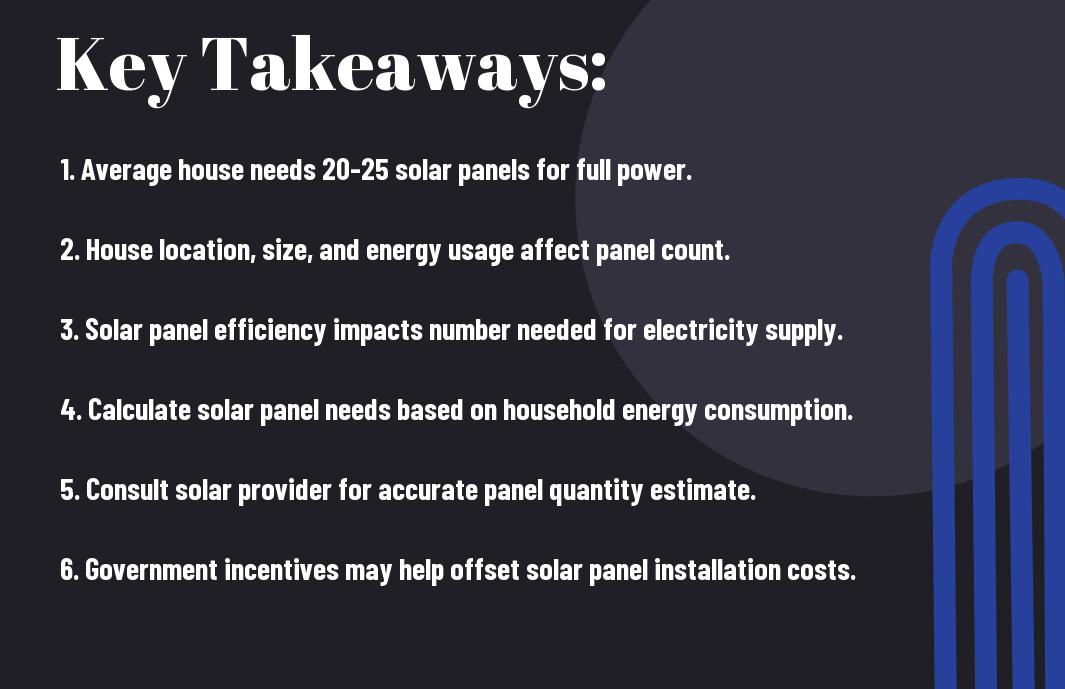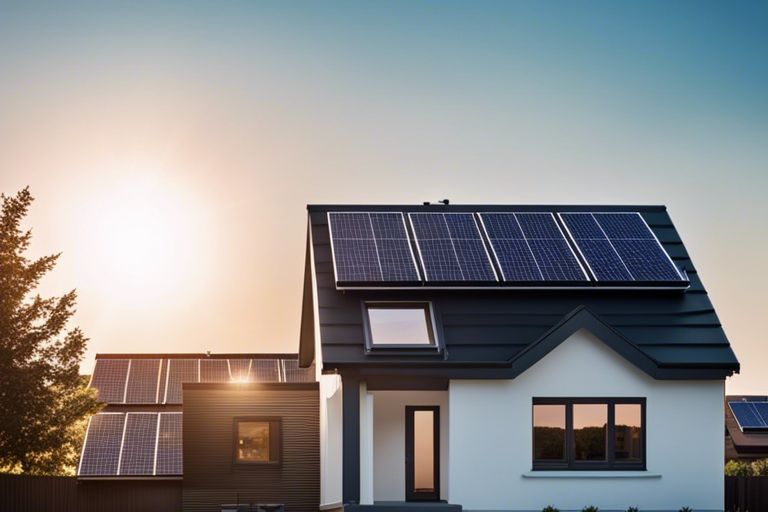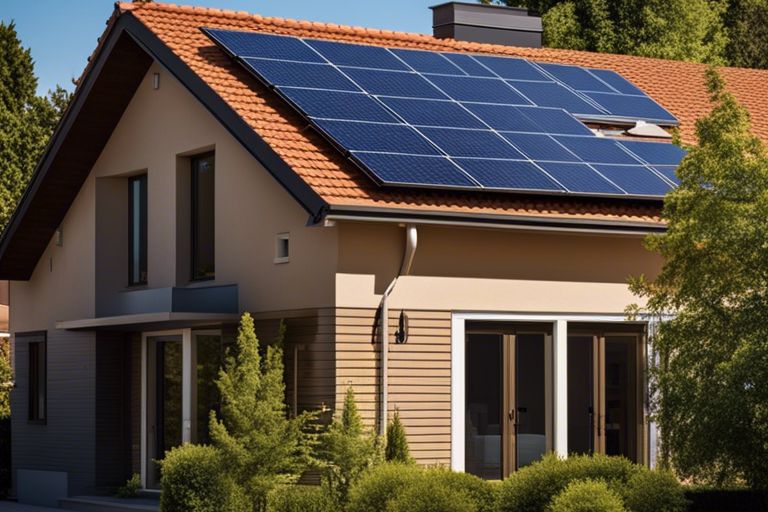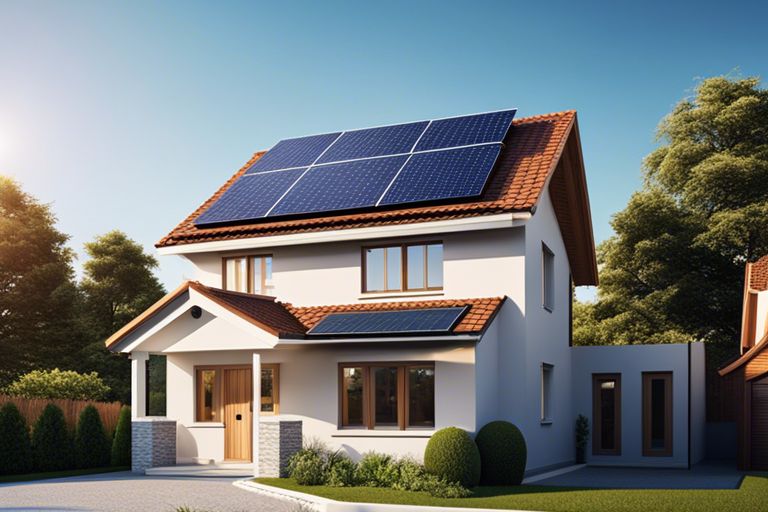Panels shining under the sun bring more than just energy – they bring possibilities. Ever wondered how many solar panels it takes to power your house sustainably? The answer lies in understanding your energy consumption, roof size, and sunlight exposure. Let’s explore the world of solar power and find out just how many panels you need to embrace a greener future for your home. You might be surprised at the impact a few panels can have on your household energy needs. So, let’s get started!
Key Takeaways:
- Energy Needs: The number of solar panels required to supply a single house with electricity is dependent on the energy needs of the household.
- Location: The location of the house plays a significant role in determining the number of solar panels needed, as it affects the amount of sunlight the panels can receive.
- Efficiency and Size: The efficiency and size of the solar panels will also impact how many are needed to power a house, with more efficient panels requiring fewer in number.


The Average Energy Consumption of a House
Before entering into how many solar panels you need to supply your house with energy, it’s necessary to understand the average energy consumption of a typical household. The average energy consumption of a house can vary based on multiple factors, including the size of the house, the number of occupants, the climate in which you live, and the energy efficiency of your appliances and home systems.
Factors Affecting Energy Consumption
- The size of your house plays a significant role in determining your energy consumption. Larger houses generally require more energy to heat, cool, and light up.
- The number of occupants in your house can also impact your energy usage. More people in the house mean more showers, more laundry, and more electronic devices being used.
Perceiving how these factors interplay can give you a clearer picture of your household’s energy needs.
Typical Energy Usage Patterns
With all these factors at play, it’s crucial to identify the typical energy usage patterns in your home. The typical energy usage patterns in a house usually follow a daily cycle, with peaks during mornings and evenings when people are getting ready for the day or relaxing after work.
The appliances and electronics you use, such as air conditioning, heating systems, refrigerators, and lighting, contribute significantly to your energy consumption. Energy-efficient appliances and practices can help reduce your overall energy usage and lower your electricity bills.
Solar Panel Basics
How Solar Panels Generate Electricity
Any homeowner can benefit from understanding the basics of how solar panels generate electricity. It all starts with the photovoltaic cells within the panels. These cells absorb sunlight, which is made up of tiny particles of energy called photons. When the photons interact with the silicon cells, they knock electrons loose, creating an electric current.
Types of Solar Panels and Their Efficiency
Efficiency is a key factor when considering types of solar panels for your home. There are three main types: monocrystalline, polycrystalline, and thin film. Each type varies in efficiency and cost, so it’s vital to choose one that aligns with your energy needs and budget.
- Monocrystalline panels have the highest efficiency rates and space efficiency, making them ideal for those with limited roof space.
- Polycrystalline panels are slightly less efficient and cost-effective than monocrystalline panels, but they are still a good option for many homeowners.
- Thin film panels are the least efficient but also the most cost-effective option. They work best in large commercial installations rather than residential settings.
Perceiving the differences in efficiency and cost among these types of solar panels can help you make an informed decision that suits your energy goals.
| Monocrystalline | Highest efficiency rates |
| Polycrystalline | Slightly less efficient than monocrystalline |
| Thin Film | Least efficient but most cost-effective |

Calculating the Required Number of Solar Panels
Determining the Total Wattage Needed
Your first step in calculating the required number of solar panels for your house is to determine the total wattage needed to power your home. Any energy assessment will show you the average daily wattage consumption in kilowatt-hours (kWh). To convert this to watts, remember that 1 kWh is equal to 1,000 watts. So if your home uses 30 kWh per day, the total wattage needed is 30,000 watts.
Accounting for Peak Sun Hours and Shading
When calculating the number of solar panels required, you must also consider the peak sun hours in your region and any shading that may affect your panels’ efficiency. Accounting for peak sun hours helps you determine how much energy your solar panels can produce on an average day. Likewise, shading from trees, buildings, or other obstructions can reduce the amount of sunlight your panels receive, impacting their efficiency.
Accounting for peak sun hours and shading is crucial for accurately sizing your solar panel system. By analyzing these factors, you can determine the optimal placement and number of panels needed to generate enough electricity to power your home efficiently.
Required determining the total wattage needed and accounting for peak sun hours and shading are vital steps in calculating the required number of solar panels for your house. By carefully considering these factors, you can ensure that your solar panel system meets your energy needs effectively.
Roof Size and Orientation Considerations
Now, when considering how many solar panels you need to supply your house with energy, it’s vital to assess your roof space and any potential obstacles that may affect solar panel installation.
Assessing Roof Space and Obstacles
Obstacles such as chimneys, vents, or shade from nearby trees can impact the efficiency of your solar panels. Before installing solar panels, make sure to evaluate your roof space to determine the best positioning for optimal sunlight exposure. If there are any obstacles present, you may need to consider adjusting the layout of your solar panel array to avoid shading issues and maximize energy production.
Ideal Roof Orientation for Maximum Energy Harvesting
For maximum energy harvesting, the ideal roof orientation for solar panels is typically facing south in the northern hemisphere or north in the southern hemisphere. This orientation allows your solar panels to receive the most sunlight throughout the day, maximizing energy production. Additionally, the tilt angle of your roof can also affect energy generation, with a slope that matches your latitude usually being the most efficient.
Understanding the ideal roof orientation and tilt angle for solar panels can significantly impact the amount of energy your system produces. By optimizing these factors, you can ensure that your solar panels generate as much energy as possible to power your home.
System Configuration and Inverter Selection
String Inverters vs. Microinverters
For your solar panel system, you have the option to choose between string inverters and microinverters. String inverters are typically less expensive and are installed outside near your electrical panel. They are connected to several solar panels in a series, converting DC electricity to AC electricity for your home. On the other hand, microinverters are installed on each solar panel, offering better performance in shaded areas and greater flexibility in system expansion.
Optimizing System Design for Energy Yield
Selection For optimal energy yield from your solar panel system, it’s crucial to consider the system design and components. Factors such as shading, roof orientation, and panel tilt angle can impact the efficiency of your system. By selecting the right combination of solar panels, inverters, and racking systems, you can maximize your energy production and reduce your electricity bills.
Energy To ensure you get the most out of your solar panel system, work with a professional installer who can assess your property and design a customized system that suits your energy needs. By optimizing the system design, you can take full advantage of solar energy and enjoy the benefits of clean, renewable power for your home.
Local Regulations and Incentives
Net Metering and Grid Connection Policies
Many local regulations and incentives can play a significant role in determining how many solar panels it takes to supply one house with energy. One key aspect to consider is net metering and grid connection policies in your area. These policies dictate how you can connect your solar panels to the grid, and how excess energy produced by your panels is credited or compensated.
Federal and State Tax Credits for Solar Installations
Local regulations and incentives also include federal and state tax credits for solar installations. These credits can significantly reduce the upfront cost of installing solar panels on your home. By taking advantage of these incentives, you can make solar energy more affordable and accessible for your household.
Additionally, federal and state tax credits can help offset the initial investment in solar panels, making it a more attractive option for homeowners looking to go green and save on energy costs in the long run.
To wrap up
From above, you now have a better understanding of how many solar panels it takes to supply one house with electricity. Bear in mind, the number of solar panels needed can vary depending on factors such as energy consumption, location, panel efficiency, and hours of sunlight. It’s important to consult with a solar energy expert to determine the best setup for your specific needs.
Switching to solar energy can not only help reduce your carbon footprint but also save you money in the long run. By investing in solar panels for your home, you can take a step towards a greener and more sustainable future while enjoying the benefits of renewable energy. So, why wait? Start exploring your solar panel options today and make the switch to clean energy!
FAQ
Q: How many solar panels does it take to supply power to one house?
A: The number of solar panels needed to power a house depends on several factors, including the size of the house, the amount of electricity the household consumes, the efficiency of the solar panels, and the amount of sunlight the location receives. On average, a typical residential solar panel system in the United States consists of 20-25 panels, which can generate enough electricity to power a standard household.
Q: What size solar panel system is ideal for a house?
A: To determine the ideal size of a solar panel system for a house, you should consider the household’s energy consumption, the available roof space for solar panel installation, the orientation of the roof, and the amount of sunlight the location receives. A professional solar energy provider can assess these factors and recommend the appropriate size of the solar panel system for your house.
Q: How can I calculate the number of solar panels needed for my house?
A: You can calculate the number of solar panels needed for your house by first determining your household’s daily electricity consumption in kilowatt-hours (kWh). Then, you can estimate the amount of sunlight your location receives per day and the efficiency of the solar panels you plan to install. By considering these factors, you can determine the total capacity of the solar panel system required to meet your house’s energy needs.
